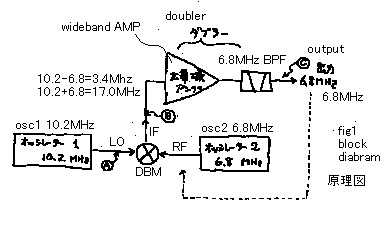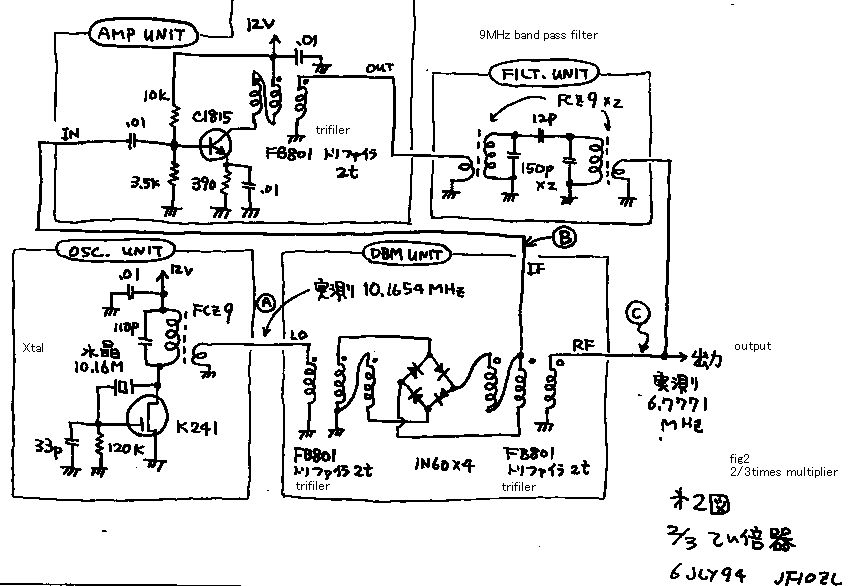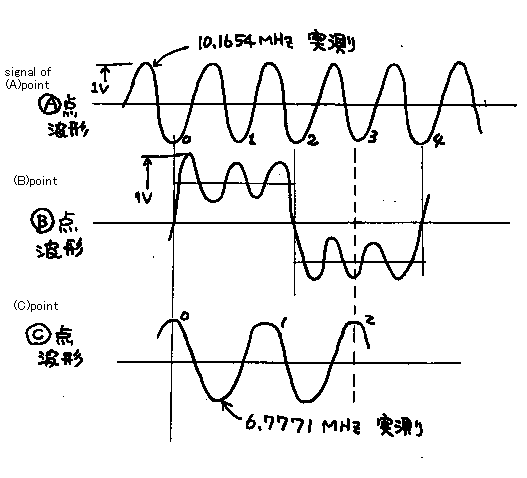
2/3 times multiplier---qwe.blockk.gif

Please see the block diagram. The first
oscillator makes 10.2 MHz signal. And this signal is supplied to the local port
of the double balanced modulator. Second Oscillator makes 6.8MHz signal. And
this signal is supplied to the RF port of the double-balanced-modulator.
Therefore double balanced mixer makes 3.4MHz signal, as a difference of 10.2MHz
and 6.8MHz. Wide band-amplifier makes 6.8 MHz signal from 3.4MHz signal. Wide
band-amplifier, with continuing band-pass-filter, works for a double
multiplier. Then I can get 6.8MHz signal on the output of this double
multiplier. Therefore I have no need to make the second oscillator, because
6.8MHz signal is supplied from the double multiplier. Please see the circuit! This
circuit does not have the second oscillator. And totally with these circuits, I
can get 6.8MHz from 10.2 MHz single crystal oscillator. Can you believe what I
say? I am not magician.
At last of this page, I must say you that I cannot know the practical usage
of these 2/3 multiplier. It will be good for the exercise of your brain,
will not?
2/3逓倍器
まず、ブロックダイアグラムをご覧になって下さい。第一発振器に,10.2MHz を発振させます。そして,この信号を,ダイオードDBMのローカルポートに供給します。いっぽう、第二発振器を作成し,6.8MHzを発振させます。そして,この信号は,ダイオードDBMの高周波(RF)ポートに供給しておきます。すると、上記の2つの信号、すなわち10.2MHz
および6.8MHzの差として,ダイオードDBMミキサーは,3.4MHz を出力します。この3.4MHz信号を広帯域増幅器で増幅逓倍して、6.4MHz信号を作ります。すなはち、広帯域増幅器とバンドパスフィルターは,全体として、ダブラーとして働きます。その時,6.8MHzの信号を、このダブラーの出力として得る事ができます。6.8MHz
信号が,ダブラーから供給されるので,さきほど「作ります」といった第二発振器は、作る必要がありません。回路図を見て下さい。第二発振器は,ありません。それでも,ちゃんと、10.2メガヘルツの信号から6.8MHzを得ることができました。ちょっとと信じられませんか?
うそだろうって!正直言って私も自分で作って動作を確認するまでこの回路がうまく働くとは信じられませんでした。
2/3分周できたからといって、なにか特に役立つ用途は思い当たりませんが、頭の体操にはなります。HIHI
qwe-circuit.gif

qwe,wave.gif
